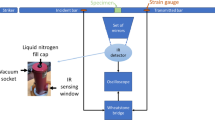Abstract
Generally, many previous researches conducted using FBG sensors were based on the assumption that the coefficient of thermal expansion (CTE) and the thermo-optic coefficient (TOC) of FBG sensors are constants. However, they should be considered variables for higher accuracy when FBG sensors are applied to circumstances with temperature changes. In this paper, CTE and TOC of FBG sensors were precisely investigated from ambient room temperature (293 K) to cryogenic temperature (113 K). For this purpose, a new non-linear relationship between the wavelength shift and temperature change was proposed. From the test results, it was successfully investigated that the sum of CTE and TOC had a non-linear dependency on temperature changes and varied from 5.9×10-6 /K (293 K) to 1.6×10-6 /K (113 K).
Similar content being viewed by others
Abbreviations
- λ B :
-
Bragg wavelength
- Λ:
-
Grating period
- n e :
-
Effective refractive index
- α f :
-
Coefficient of thermal expansion (CTE)
- ξ f :
-
Thermo-optic coefficient (TOC)
- K f :
-
Thermal coefficient
- p e :
-
photoelectric constant
- ν:
-
Poisson’s ratio
- ε:
-
Strain
- T :
-
Temperature
References
Cho, T.-S., Choi, K.-S., Seo, D.-C., Kwon, I.-B., and Lee, J.-R., “Novel Fiber Optic Sensor Probe with a Pair of Highly Reflected Connectors and a Vessel of Water Absorption Material for Water Leak Detection,” Sensors, vol. 12, no. 8, pp. 10906–10919, 2012.
Kim, H. Y. and Kim, D. H., “Sensor System for Multi-Point Monitoring using Bending Loss of Single Mode Optical Fiber,” Journal of the Korean Society for Nondestructive Testing, vol. 35, no. 1, pp. 39–45, 2015.
Kang, D. and Chung, W., “Integrated Monitoring Scheme for a Maglev Guideway using Multiplexed Fbg Sensor Arrays,” NDT & E International, vol. 42, no. 4, pp. 260–266, 2009.
Kim, D.-H. and Feng, M. Q., “Real-Time Structural Health Monitoring using a Novel Fiber-Optic Accelerometer System,” IEEE Sensors Journal, vol. 7, no. 4, pp. 536–543, 2007.
Kang, D., Kim, C. U., and Kim, C. G., “The Embedment of Fiber Bragg Grating Sensors into Filament Wound Pressure Tanks Considering Multiplexing,” NDT & E International, vol. 39, no. 2, pp. 109–116, 2006.
Esposito, M., Buontempo, S., Petriccione, A., Zarrelli, M., Breglio, G., et al., “Fiber Bragg Grating Sensors to Measure the Coefficient of Thermal Expansion of Polymers at Cryogenic Temperatures,” Sensors and Actuators A: Physical, vol. 189, pp. 195–203, 2013.
Chung, Y.-J., Song, J.-S., Han, W.-T., and Paek, U.-C., “New Compensation Method for Temperature Sensitivity of Fiber Brags Grating using Bi-Metal,” Journal of the Optical Society of Korea, vol. 7, no. 2, pp. 84–88, 2003.
Kim, K. T., Kim, I. S., Lee, C.-H., and Lee, J., “A Temperature- Insensitive Cladding-Etched Fiber Bragg Grating using a Liquid Mixture with a Negative Thermo-Optic Coefficient,” Sensors, vol. 12, no. 6, pp. 7886–7892, 2012.
Kang, S.-G., Kang, D.-H., and Kim, C.-G., “Real-Time Monitoring of Transverse Thermal Strain of Carbon Fiber Reinforced Composites under Long-Term Space Environment using Fiber Optic Sensors,” NDT & E International, vol. 42, no. 5, pp. 361–368, 2009.
Kamikawachi, R., Abe, I., Paterno, A., Kalinowski, H., Muller, M., et al., “Determination of Thermo-Optic Coefficient in Liquids with Fiber Bragg Grating Refractometer,” Optics Communications, vol. 281, no. 4, pp. 621–625, 2008.
Kang, D., Kim, H.-Y., and Kim, D.-H., “Enhancing Thermal Reliability of Fiber-Optic Sensors for Bio-Inspired Applications at Ultra-High Temperatures,” Smart Materials and Structures, vol. 23, no. 7, Paper no. 074012, 2014.
Udd, E., “Fiber Optic Smart Structures,” John Wiley and Sons, pp. 271–285, 1995.
Li, E., “Temperature Compensation of Multimode-Interferencebased Fiber Devices,” Optics Letters, vol. 32, no. 14, pp. 2064–2066, 2007.
Author information
Authors and Affiliations
Corresponding author
Rights and permissions
About this article
Cite this article
Kang, D., Kim, HY., Kim, DH. et al. Thermal characteristics of FBG sensors at cryogenic temperatures for structural health monitoring. Int. J. Precis. Eng. Manuf. 17, 5–9 (2016). https://doi.org/10.1007/s12541-016-0001-4
Received:
Revised:
Accepted:
Published:
Issue Date:
DOI: https://doi.org/10.1007/s12541-016-0001-4




